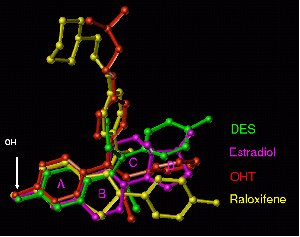Disclaimer & Copyright Notices; Optimized for the MS Internet Explorer

Endocrine disrupting compounds (EDC's) are chemicals that either mimic endogenous hormones, interfere with pharmacokinetics or act by other mechanisms.
"An exogenous agent that interferes with the production, release, transport, metabolism, binding, action or elimination of natural hormones in the body responsible for the maintenance of homeostasis and the regulation of developmental processes."
This definition includes the general types of mechanisms for endocrine disruptors. Such adverse effects as compromised reproductive fitness, functional or morphological birth defects, cancer and altered immune functions, among others, have been reported in the scientific press for wildlife, in vitro, and in vivo studies. These findings have received considerable attention in the popular press, led to government regulatory actions and expanded research in Europe, Asia and the U.S. Many suspected endocrine disruptors (ED's) are high-volume, economically important chemicals, a factor that magnifies the need for resolution of the scientific issues.
"Canadian scientists are among the world’s leaders in studying reproduction and developmental effects on wildlife populations. Their research, particularly in the Great Lakes, has been vital in bringing international attention to the issue. Recently, scientists have seen a variety of endocrine-related effects in fish and wildlife in many parts of the world, including Canada. Fortunately, in many of these cases, action has been taken to reduce exposure, and at least some wildlife populations have recovered."
![]() Endocrine Disruptors and Hog Manure
Endocrine Disruptors and Hog Manure
![]() Endocrine Disruptors Research Initiative
Endocrine Disruptors Research Initiative
![]() Vitellogenin Gene Expression in the Male Fathead Minnow as an Indicator of Exposure to Endocrine Disrupting Chemicals (EDCs) in an Aquatic Environment
Vitellogenin Gene Expression in the Male Fathead Minnow as an Indicator of Exposure to Endocrine Disrupting Chemicals (EDCs) in an Aquatic Environment
Endocrine Disrupting Chemicals (EDC's):
"Considerable evidence exists that aquatic organisms are being exposed to, and impacted by, a wide range of compounds that mimic hormones. Fish exposed to these compounds often exhibit an array of responses including depressed circulating sex steroid levels, reduced gonad size and fecundity, and males have become feminized. One of the most sensitive and common tools used to assess exposure to endocrine disrupting chemicals (EDCs) with estrogenic activity is the presence of vitellogenin (VTG), an egg yolk protein precursor, in the plasma of male fish. Recent studies have shown elevated plasma VTG in male fish downstream of sewage treatment plants."
Estrogen Addition to ELA Lake 260 (Hormone Mimics)
"Of ultimate concern in any treatment process is an assessment of the treatment success in elimination of the toxic action of the parent pollutant. Mineralization of the pollutant would require extended UV treatment times and in many cases would not be practical. Thus, as with any oxidation process, breakdown products will be formed. The relative threats of these products, as compared to their parent compounds, must be assessed through toxicological testing.
The EDCs used in this study included bisphenol A (BPA), ethinyl estradiol (EE2), and estradiol (E2) and were chosen because of their environmental relevance and frequent human exposure. All three have been found in streams throughout the United States, England, and Japan. Also, each compound is relevant in terms of human exposure.
BPA is a plasticizer used in the production of numerous plastic articles , including the plastic lining of food storage cans and polycarbonate babies' bottles. EE2 is one of the most commonly used active ingredients in oral contraceptives, and E2 is the natural female hormone, estrogen.
Because many EDCs can only be partially removed with conventional water treatment systems, there is a need to evaluate alternative treatment processes. The degradation of these EDCs using monochromatic and polychromatic UV radiation from low- and medium-pressure lamps, respectively, with and without the addition of H2O2 was evaluated. Kinetic parameters were developed in an effort to model the destruction of EDCs by UV and UV/H2O2 in a variety of water quality matrices.
The polychromatic medium-pressure (MP) UV radiation source was more effective for direct photolysis degradation as compared to conventional low-pressure (LP) UV lamps emitting monochromatic UV 254 nm radiation. However, in all cases the EDCs were more effectively degraded utilizing UV/H2O2 advanced oxidation as compared to direct UV photolysis treatment."
We salute the Chebucto Community Net (CCN) of Halifax, Nova Scotia, Canada for hosting our web site, and we applaud its volunteers for their devotion in making `CCN' the best community net in the world